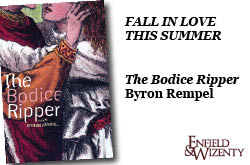Articles
A Poet's Perspective on Self-Publishing
By Patricia Young
A friend tells me she is reviewing two books— a short story collection and a novel — for a literary magazine. One is published with a well-known publishing house and the other is self-published. MORE >
Mid-List Gone, E-books Here, Time to Self-Pub?
By Rachael Preston
“Most TWUCers,” writes John Harris of The Writers’ Union of Canada’s members, “think self-publishing is demeaning, that it’s not much better than wanking MORE >
Interviews
Sandra Kasturi on the Advantages of Small Furry Animals in Publishing
One Good Chat: An Interview with Billie Livingston
New Work
#notpronouncedtoes #3
By Nathan Dueck
Parliamentary Activity of the Honourable @evictsow: MORE >
Excerpts
Book Reviews
-
‘Tenth of December: Stories’ by George Saunders
In a recent interview on KCRW’s Bookworm, the show’s host, Michael Silverblatt, suggested to his guest, George Saunders, that suffering as our state on earth lies at the root of his work. MORE >
-
‘Cosmo’ by Spencer Gordon
Well, it’s finally happened. “Popular culture,” that realm of celebrity stalkers, glitzy ad campaigns, pro wrestling, Disney-channel starlets, and round-the-clock news coverage of mass shootings, has broken through into “serious” literature. MORE >
-
‘The Inner City’ by Karen Heuler
I couldn’t help but glut myself on Karen Heuler’s stories, devouring her words and ideas. A New York resident and O. Henry Award-winning author, Heuler blurs the line between genres. MORE >
-
‘The Cloaca’ by Andrew Hood and ‘Whirl Away: Stories’ by Russell Wangersky
F. Scott Fitzgerald published “The Crack-Up” as a three-part series in the February, March and April 1936 issues of Esquire. MORE >
-
‘The Blondes’ by Emily Schultz
 Reviewed by Elizabeth Bricknell
Reviewed by Elizabeth BricknellThe Blondes is a reviewer’s nightmare. Doing it justice is nigh impossible, revealing any of the plot is an unfair spoiler to the reader and the author, and picking exemplary quotes is as difficult as ordering from a five-star restaurant. MORE >












‘The World’ by Bill Gaston
There it is. I’m well into Bill Gaston’s latest offering, a novel called The World, and I consciously slow down. I’m no speed-reader. I read at a normal pace–not as fast as some of my editors would like (sorry about that). But my normal pace slowed because I suddenly realized I did not want this book to end. The flavours and strands of narrative preceding this point began to expand. It was a wow moment. I began to savour. I still did not know what was going to happen next but I knew something scintillating was going on and that I was in really good hands. The World is a touching, joyous, heart-breaking and clever-as-hell novel.
Gaston shows us his story in three parts and in each part we are seeing the world through the eyes, heart and mind of a different character. These subtle shifts in point of view deserve a great big literary BRAVO! Yes, I know I’m talking about writing tactics – the machinery that’s supposed to be under the surface, but it worked so well in this book that it deserves a nod. I was surprised and excited by these shifts.
We start with Stuart, a fifty-one year old retired school teacher who has recently divorced, invested all his retirement savings into paying off his mortgage, and then accidentally starts a fire and destroys his house with the smoldering mortgage papers. The second part is Melody, or Mel – an old friend of Stuart’s who is dying from cancer. Mel is taking care of Hal, her elderly come-Buddhist father, who is retreating into Alzheimer’s. I know what you’re thinking. This sounds bloody depressing. But it’s not. It’s surprisingly uplifting and funny. It approaches the world with a gentle grace.
Stuart inadvertently forgot to pay his house insurance and it looks like the company won’t honour his policy. Mel can see the end coming and is looking for a series of perfect moments before the cancer is too much. Hal is living in care – in a place that for him is often back in Tibet surrounded by monks. It seems Stuart is all about the future, Mel is living in the past and striving for the present, and Hal is the uncarved block – everything is new and everything is in the present. How clever is that?!
Stuart gets into his creaky Datsun in Victoria and, in order to drop in on Mel in Toronto, drives across the country. This section is paced perfectly – interspersed with some found characters, and memories, and allows Stuart to slip further and further down the rabbit hole. He winds up with his head shaved because of lice, broke, carless, homeless and in jail in Toronto. Enter Mel, who gives him a space to live, her friendship, and an introduction to her ailing father, Hal.
Hal is a Buddhist teacher, writer and disappeared father. Something happened back around the time his only book (called The World) was published, and he took a prayer mala from his then-wife, and vanished into Tibet to study Buddhism. Mel and Stuart are reading Hal’s book back to him, hoping he recognizes his own writing. Hal’s book is about an island leper colony off Vancouver Island, populated by Chinese immigrants. There is a rumour about a sole woman, Li, who lived among the men on that island. Enter: a metal box filled with papers, found on the now abandoned island and an offer to sell it to an ambitious history professor. Once the professor has the papers in his hands, he needs a translator. And then there is love, and betrayal, and the horrors of that leper colony woven together.
Listen: stories-within-stories are always tricky for writers. You want that embedded story to be captivating but you don’t want it to take away from your main narrative. Gaston proves to be a master here. This heartbreaking love story is perfectly tuned. It is as important to Gaston’s novel as Stuart, or Mel, or Hal.
Because Gaston’s book has been out in the world for a while, I broke my own rule and took the liberty of reading a few other reviews before tackling the one you’re reading. Not because I doubted my own mind, but because I thought it might be interesting to name names–to focus on points of disagreement. So, for the record, I did not find anything about this fabulous book to be conventional, Quill & Quire. There’s nothing predictable here. Nor did I find that there was too much detail. And, the ‘story-within-the-story’ is more than engaging, Winnipeg Free Press. And yes, I too believe this book is an “emotional, spiritual and intellectual” experience, Globe and Mail.
If ever the phrase narrative sutra was appropriate, it’s now, and for this book. These strands of story are woven together brilliantly. Gaston has balanced the elements of past, future and present with great skill and such a delicate touch. He asks those big questions about the world in The World – for example, what’s it like behind the wall of Alzheimer’s? What’s beyond death? Do insurance companies actually have a heart? Is it okay to lie in the name of love? And so many more…There were moments where I was choked, and moments in which I was laughing out loud. And the characters are still milling around in the back of my head. Yes, it’s that kind of book. The World is most certainly that kind of book.
Hamish Hamilton | 368 pages | $32.00 | cloth | ISBN # 978-0670065837